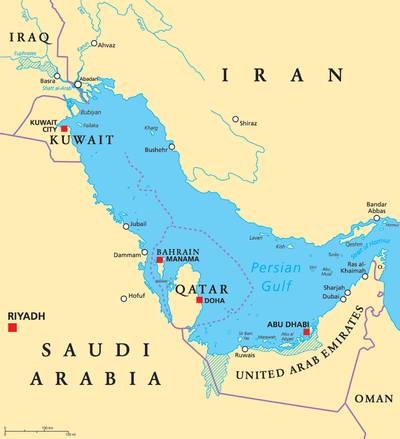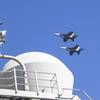Analysis: Strait of Hormuz and the Risk of Escalation
The Strait of Hormuz, the narrow shipping lane between Iran and Oman named after the fabulously wealthy ancient kingdom of Ormus, has fascinated oil traders since the Iranian revolution in 1979. Iran has periodically threatened to close the strait to enemy shipping, while the United States and its allies have pledged to keep it open and maintain freedom of navigation, by force if necessary.
The strait has become a symbolic flashpoint in the region-wide confrontation and indirect conflict between Iran on one side and the United States and Saudi Arabia on the other.
Two oil tankers were attacked and left adrift on Thursday in the Gulf of Oman, just south of the entrance to the strait, stoking fears of a new confrontation between Iran and the United States.
"The Strait of Hormuz is the world's most important chokepoint" for oil, according to the Energy Information Administration (EIA), the independent statistical and analysis arm of the U.S. Department of Energy.
Roughly 30% of all the world's seaborne flow of crude and products passes through the strait each year, so closure could result in a major disruption of global oil supplies ("World transit chokepoints", EIA, July 2017).
During the Iran-Iraq war (1980-1988), both countries targeted tankers - with Iraq attacking vessels loading around Iran's Kharg island in the northern Gulf, and Iran targeting ships further south and in the strait itself.
In the tanker war, the United States, the United Kingdom and several other countries responded by pledging to protect shipping in the central and southern parts of the area and arranging naval convoys.
The strait itself is only 21 miles wide at its narrowest point, and tankers are confined to an even narrower shipping lane just two miles broad in each direction, with a traffic separation scheme to reduce the risk of collision.
The limited room for manoeuvre substantially increases the vulnerability of slow-moving tanker traffic to attacks from either the shore or hostile vessels within the strait itself.
In practice, as the tanker war illustrated, the theatre of operations is much wider, including the entire Gulf, the strait and the neighbouring Gulf of Oman, Arabian Sea and the southern Red Sea.
CHOKEPOINT
Iran has several options for targeting enemy shipping, including mines, coastal missile batteries, submarines, navy vessels, and a fleet of small fast and highly manoeuvrable boats operated by the country’s revolutionary guard.
In the tanker war, most of the damage was done by mines, shore-based Silkworm missiles and speedboat attacks employing rocket-propelled grenades and gunfire (“The Tanker War”, U.S. Naval Institute, 1988).
Despite Iran’s threats, and thousands of pages of analysis published on the country’s capability to close the strait, it is unlikely the country could block the strait to shipping for more than a few days or a couple of weeks.
Efforts to close the strait would be interpreted by the United States and its allies as an act of aggression and draw an overwhelming military response.
Given U.S. aerial and maritime superiority in the area, the United States would probably be able to suppress onshore missile batteries as well surface and submarine naval activity and speedboats.
Assuming the United States and allied naval forces are willing to provide convoy protection again, Iran would not be able to attack escorted tankers without coming into direct conflict with U.S. warships.
ESCALATION
The real problem is that armed conflict in the strait could escalate into a broader conflict between the United States and Iran across multiple sub-theatres.
Possible sub-theatres include Yemen, eastern Saudi Arabia, the United Arab Emirates, Bahrain, Iraq, Syria, Afghanistan, and further afield, as well as the interior of Iran itself (a repeat of the war of the cities in the 1980s).
Concern about armed conflict in the strait is really concern about uncontrolled escalation between the United States and its allies and Iran.
For the moment, the United States is publicly committed to a policy of controlled escalation, employing progressively tighter economic sanctions to force Iran to negotiate on nuclear and other issues.
Senior U.S. officials have reassured their counterparts in Europe, Russia and China that controlled economic escalation is a viable alternative to military confrontation.
U.S. diplomats tend to refer to this approach as "coercive diplomacy" and present it to sometimes sceptical foreign audiences as an alternative to inevitable war.
(U.S. sanctions on Iraq in the 1990s and the run-up to the 2003 Iraq War provide a fascinating and controversial case study of whether coercive diplomacy is a genuine alternative to war or simply a prelude to armed conflict.)
But coercive diplomacy requires exquisite calibration of the degree of pressure to ensure controlled escalation does not spiral into uncontrolled escalation.
TINDER BOX
The United States has sharply increased economic pressure on Iran by eliminating all waivers for buyers of Iran’s crude oil from the start of May and is now threatening the country’s petrochemical exports.
Dramatic economic escalation has been followed by a series of attacks on shipping that have been blamed by some on Iran; a missile attack in Baghdad; intelligence reports of hostile activity aimed at U.S. forces; and the deployment of additional U.S. troops to the region.
As sanctions relief promised to Iran under the 2015 nuclear agreement has evaporated, Tehran has stepped up nuclear activities and threatened to stop complying with some of the accord’s other terms.
The abrupt escalation of tensions seems to have caught at least some policymakers on all sides unprepared and led to a recent scramble to de-escalate.
The United States has publicly disavowed regime change as an objective, offered negotiations without preconditions, and highlighted the small number of additional troops being sent to the region.
Iran has stated it does not want war and has released a previously detained U.S. resident, both of which appear to be confidence-building measures.
Diplomats and top policymakers from Switzerland, Germany and Japan all appear to be involved in efforts to mediate between the two sides.
CONTROL
Top U.S. policymakers appear convinced they have achieved “escalation dominance”, allowing them to dial-up and dial-down pressure on Iran at will and precisely without too much risk.
In this scenario, Iran’s best option is always to accept the degree of pressure applied by the United States, however unpleasant, rather than risk escalating even further (“On escalation: metaphors and scenarios”, Kahn, 1965).
Right now, the United States is committed to keeping economic pressure in place, while avoiding an outbreak of direct armed conflict.
That means convincing allies to maintain sanctions while calculating that Iran will continue to abide by most of the provisions of the nuclear agreement and avoid military provocations. De-escalating the military confrontation while leaving the economic pressure campaign in place.
But in such a tense environment, there is always the risk that a minor incident or accident will escalate in ways not planned by top policymakers.
Top leaders may not have full control over subordinates, proxies and allies, and could find themselves pushed towards a conflict they insist they do not want.
Iran may not have full control over the militias it has armed in Yemen. The United States may not have full control over hawkish elements in Saudi Arabia, the United Arab Emirates and Israel that want war with Iran.
In the current state of high tension, hawkish elements in both the U.S. administration and the Iranian government may exploit any incident to push their respective leaders to escalate.
The vulnerability of tankers in the Strait of Hormuz is precisely the sort of incident that could spark an unplanned and uncontrolled escalation.
Hormuz is not important because of the volume of oil that flows through the strait daily, but because it is an ultra-tense flashpoint that could spark a much broader conflict both sides insist they do not want.













